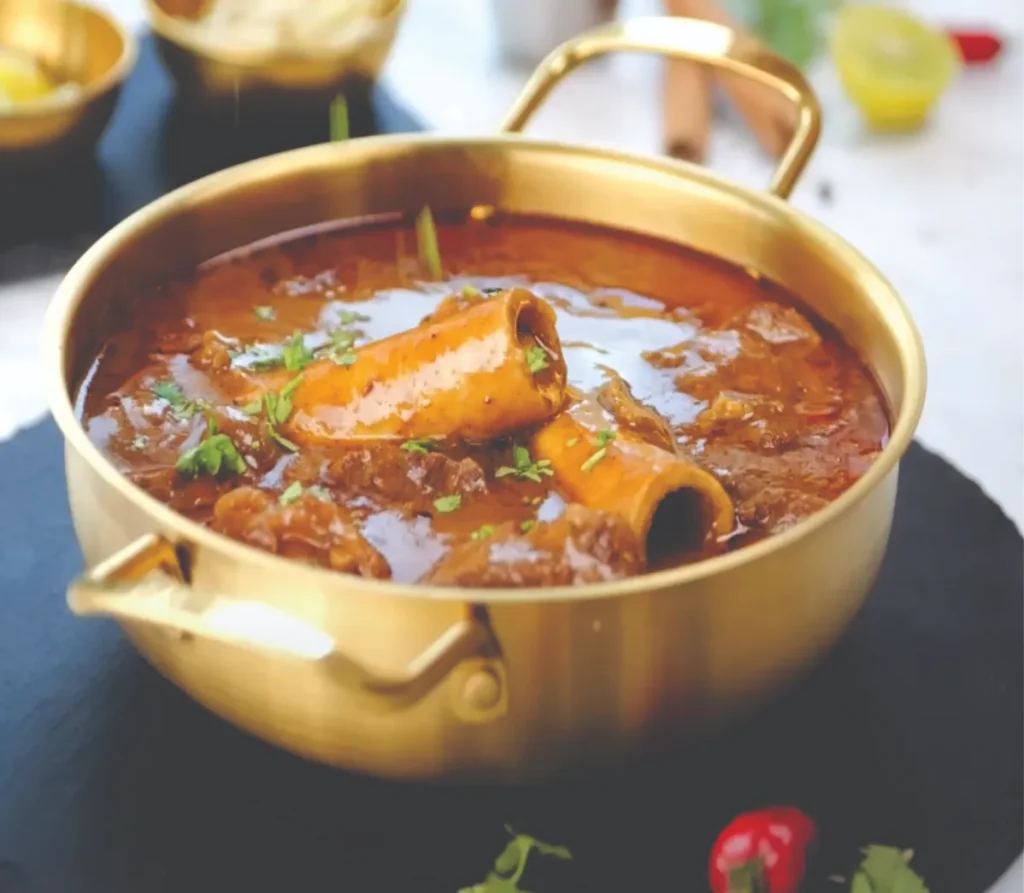Origin of Nihari
Nihari originates from the Indian subcontinent, specifically in the Mughal kitchens of Delhi during the late 17th century. The name “Nihari” is derived from the Arabic word “Nahar,” meaning “morning,” as it was traditionally consumed as a breakfast dish after the morning prayers. Over time, Nihari has become a beloved dish in Pakistan and India, symbolizing richness and hospitality. Its slow-cooked, aromatic nature reflects the culinary finesse of the Mughals.
Continent
Countries
- India
- Pakistan
Season
Winter / All Season
Category
- Main Course
- Non-Vegetarian
- Spicy Food
Nihari Ingredients
| Ingredient | 4 Servings | 6 Servings | 8 Servings | 10 Servings |
| Beef Shank (bone-in) | 500g | 750g | 1kg | 1.25kg |
| Wheat Flour (atta) | 2 tbsp | 3 tbsp | 4 tbsp | 5 tbsp |
| Ghee or Cooking Oil | 1/4 cup | 1/3 cup | 1/2 cup | 2/3 cup |
| Ginger-Garlic Paste | 2 tbsp | 3 tbsp | 4 tbsp | 5 tbsp |
| Onions (finely sliced) | 2 medium | 3 medium | 4 medium | 5 medium |
| Nihari Masala* | 3 tbsp | 4 tbsp | 5 tbsp | 6 tbsp |
| Water | 6 cups | 8 cups | 10 cups | 12 cups |
| Lemon Wedges | For garnish | For garnish | For garnish | For garnish |
| Fresh Coriander Leaves | 1/4 cup | 1/3 cup | 1/2 cup | 2/3 cup |
| Ginger Juliennes | 2 tbsp | 3 tbsp | 4 tbsp | 5 tbsp |
| Green Chilies (optional) | 2 | 3 | 4 | 5 |
Nihari Masala (Homemade Blend)
| Spice | Quantity (per serving) | Calories (per serving) | Key Nutrients |
| Red Chili Powder | 1 tsp | 6 | Vitamin C, Iron |
| Turmeric Powder | 1/2 tsp | 4 | Manganese, Iron |
| Coriander Powder | 2 tsp | 7 | Calcium, Vitamin C |
| Cumin Powder | 1 tsp | 8 | Magnesium, Iron |
| Fennel Seeds | 1 tsp | 5 | Calcium, Potassium |
| Cloves (ground) | 1/4 tsp | 6 | Manganese, Vitamin K |
| Cinnamon (ground) | 1/2 tsp | 3 | Calcium, Iron |
| Black Cardamom (ground) | 1 pod | 2 | Fiber, Vitamin B6 |
| Star Anise (ground) | 1 piece | 2 | Calcium, Phosphorus |
Instructions
- Prepare the Masala: If making homemade Nihari masala, dry roast the spices and grind them into a fine powder. Store in an airtight container.
- Sauté the Base: Heat ghee or oil in a large pot. Add sliced onions and cook until golden brown. Add ginger-garlic paste and sauté for 2-3 minutes.
- Cook the Meat: Add beef shank pieces and cook on medium heat for 5-7 minutes until they change color. Add Nihari masala, stirring well to coat the meat.
- Simmer the Broth: Pour water into the pot, bring it to a boil, then reduce the heat to low. Cover and let it simmer for 4-6 hours (the longer, the better for flavor and tenderness). Skim off any scum that rises to the surface.
- Thicken the Gravy: Mix wheat flour with water to create a smooth slurry. Gradually add this to the pot while stirring continuously to avoid lumps. Let it cook for an additional 30 minutes.
- Finish with Garnish: Once the gravy reaches the desired consistency, garnish with ginger juliennes, fresh coriander, lemon wedges, and green chilies.

Doctor’s Advice
- People recovering from illness can benefit from the high protein content of the beef.
- Ideal for those with low energy levels as it’s calorie-dense.
- The spices (turmeric, cinnamon, cloves) are anti-inflammatory and aid digestion.
Who Should Avoid:
- People with high cholesterol should limit consumption due to the high fat content from ghee.
- Individuals with sensitive stomachs or ulcers may find the spices too intense.
- Diabetics should consume in moderation due to the flour used for thickening.
Conclusion
Nihari boasts a rich, spicy, and aromatic taste with tender meat that melts in your mouth, complemented by the flavorful gravy. It is best served with naan or steamed rice, making it perfect for festive occasions, family gatherings, or special Sunday brunches. This royal dish is a celebration of heritage and flavor, guaranteed to leave a lasting impression.
If you want to know a specific recipe or want to contribute your own recipe in our blog, you may contact us at contactus@flavorsofnation.com or leave a message in our social media channels.
